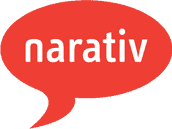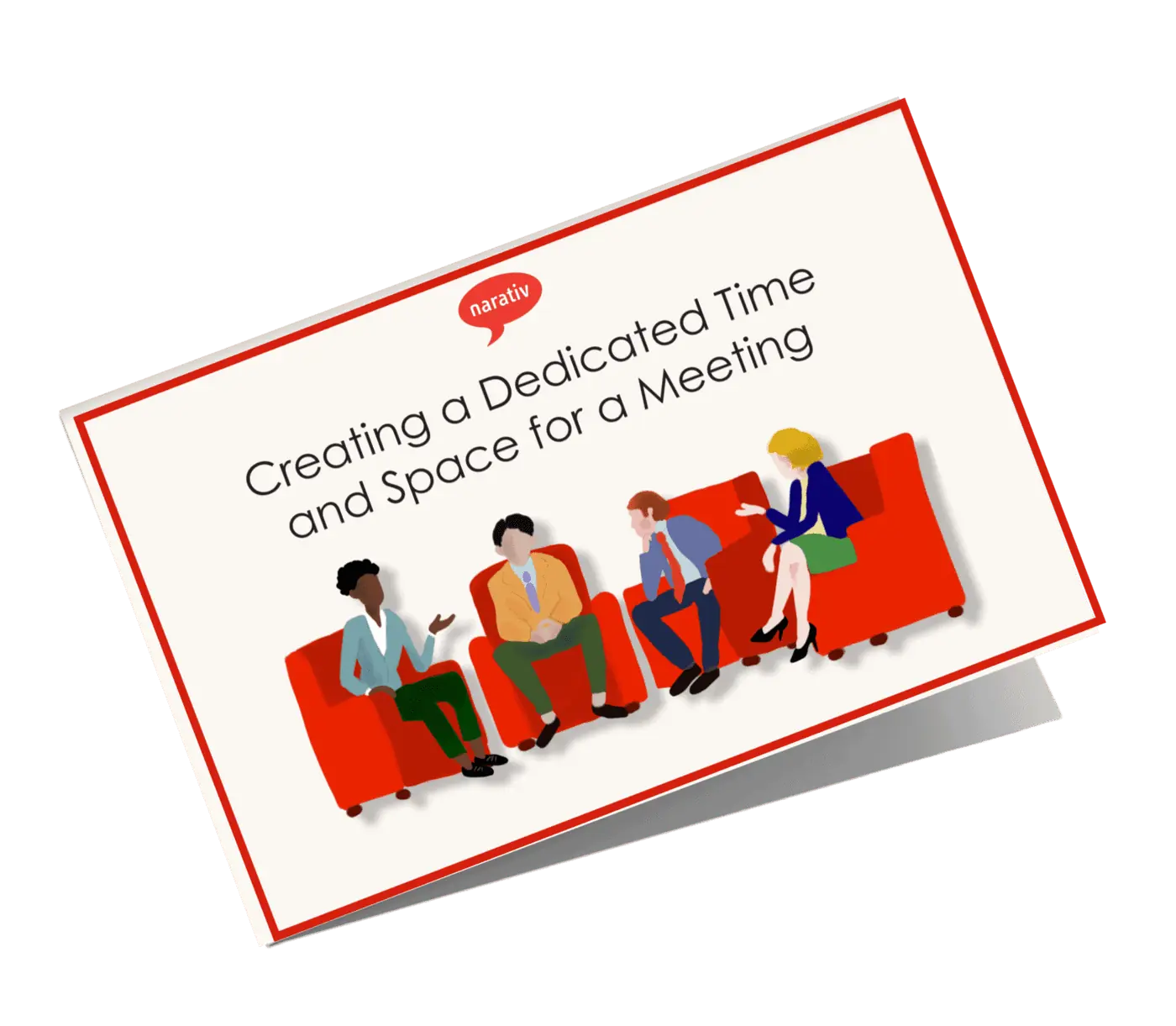Recently, Narativ’s CEO, Jerome Deroy, had the opportunity to speak with Operations Advisor and Senior Advisor for Criteria for Success, Elizabeth Frederick, on her podcast “Let’s Talk Sales.” During their conversation, they talked about the challenges and opportunities during COVID-19 and remote work for making connections and improving employee engagement through storytelling.
While remote work has eliminated the natural “watercooler conversations” of in-office interactions, it has opened up a whole new opportunity for intentional engagement. By creating space in an agenda-less meeting, employees can connect, and leaders can use these valuable stories shared to enhance their organizations.
Jerome and Elizabeth discussed Jerome’s early experiences with storytelling, the value of the virtual watercooler, and how to bottle your own magic with storytelling.
Jerome’s Story: Onboarding through Storytelling
To explain the importance of engagement in sales, Jerome relays his experience at his first job after university.
After graduating from business school in Paris, Jerome was excited to start a new job in Hong Kong at a large international bank. When he arrived on his first day, the HR representative took Jerome to an un-inspiring window-less room and set two enormous binders in front of him.
“She said, Can you read through these in the next 48 hours?” Jerome recalled. He spent the next two days straight reading the binders and only went home to sleep. After the binders, the onboarding process involved watching videos about the company and his position.
“It was a week before I met any human being at all related to my job,” he said.
Luckily for Jerome, though, his predecessor he was replacing had a hiccup in his promotion which meant he had to stay for another six months. Jerome took the opportunity to shadow him to see what it took to succeed at the job and get the connections he needed for his position. He learned the psychology behind the role and how to handle different situations successfully by watching and hearing stories about the job.
Jerome witnessed what happened to the other employees who were not as lucky to have the same knowledge transfer as him. Every few months, these employees would go into their boss’ office and came out to tell him, relieved, that they had just quit. His boss blamed the budget and was frustrated that he couldn’t offer a competitive salary.
Jerome knew, though, that salary wasn’t the real issue. The lack of engagement that employees had with the company and each other made them quit. His experience showed him how important engagement and knowledge is to success at a company.
Storytelling, like what he received from his predecessor, is essential for driving this engagement.
“Storytelling,” recalls Jerome, “has a crucial role to play in telling people not only how to do what they do but also why. It tells you why you’re a part of this collective narrative that is your company and how you can contribute to it in a way that makes you feel like you belong and like you’re important.”
The Value of the Virtual Watercooler
When organizations started using remote work at the beginning of the pandemic, they were happy to experience an increase in productivity and reduced costs. In fact, research shows that remote employees are typically about 20-25% more productive than those in the office.
However, as the pandemic and remote work wore on, companies began to notice a glaring problem with isolated employees: a lack of innovation, ideas, and engagement. The ideas that percolate naturally from conversations between employees in different departments stopped occurring. Remote work started to enforce organizational silos, and they were no longer running as effectively or improving as they once were.
In addition, the lack of engagement also created a lack of knowledge transfer. Employees started leaving and taking what they learned with them. New hires no longer had access to the information that occurs naturally in conversations in the office. Current employees also didn’t get the chance to learn more about how their talents could contribute to the organization.
But with all challenges, there was also an opportunity. These businesses could start to put a structure in place where people could apply their real-life, on-the-job learning and translate it into valuable information—virtually. It was as simple as setting up a dedicated time and virtual space and pressing record.
The companies who struggled before now have the perfect chance to easily collect information.
“I think this is a big opportunity,” Jerome mused, “for organizations that didn’t have a culture of gathering ideas. It’s the perfect opportunity because it doesn’t take much to do so.”
Remote work has created an important opportunity for everyone with storytelling. Virtual meet-ups are a perfect chance to establish the right processes to collect these stories. These “virtual watercoolers” can create constructive ideas, valuable material, and unlimited uses for businesses.
Bottling the Magic: The Stuff You Can’t Find in a Manual
While the idea of getting employees to share their stories for company use might feel intimidating at first, it doesn’t have to be. Here are four steps that can help make the story gathering process practically stress-free:
1. Set a dedicated time and space for agenda-less conversation
When you have something important to discuss with your team, you put it on the calendar. Likewise, you need to take the time on the calendar to give people the space they need to share their stories.
“Start with the basics,” Jerome advised his listeners, “When is this going to happen? Where is it going to happen? What can I do to create an environment where people can feel that they’re listened to?”
Choose a time on the calendar with enough advance notice that it minimizes conflicts. Send out a calendar invite to ensure that space is held by all participants. It is important that this meeting holds as much of a status of priority as any other.
2. Let themes and values be your conversational roadmap
One of your prime differentiators as an organization is your values. Let these values be the driver of your stories. Picking a theme can also help guide your employees to choose the right stories that everyone can use.
Jerome gave the example of a company that Narativ recently worked with that used the theme “Dare to be Different.” Their employees then came up with stories that fit into this theme and served as examples of being different from the norm.
Communicate with your employees ahead of time what values or themes you would like them to discuss. Instead of the anxiety of suddenly needing to come up with something on the spot, they can choose the right story for them that showcases your company values and will be more helpful for everyone.
3. Determine who are the right storytellers
Your employees will likely be nervous at the prospect of telling their story in front of everyone. That’s why Jerome recommends determining the right people to tell their stories first: “who are the people who could potentially model this for everyone else?”
Choose people who can represent the theme or value you want to display. How you plan on using your stories will also help determine who you choose. HR execs, for example, might provide helpful information for onboarding. On the other hand, a top-performing sales rep can inspire members of your sales team who aren’t sure where they can grow within the company.
One company worked with Narativ to gather stories that would provide a wide range of voices within the company to help with their recruiting efforts. Potential hires could hear directly from employees what it was like working at the company and see their values in action.
“As a candidate and a potential new hire, you can see what it might be like concretely to work at a company. Not just the skills you need, but who are these people you’ll be working with,” remarked Jerome.
4. Capture and organize the conversations
Have a system in place ahead of time to collect these stories. It doesn’t have to be a complicated system or require a video team to record it perfectly. Even a Zoom call is the perfect opportunity to record a conversation.
You can also have employees email their recorded stories to you. This can be especially useful because they can tag their data with specific themes or values so that you can sort through the information.
A dedicated scribe skilled at gathering both the words and their value is a critical part of using the stories. This scribe can listen and ask the right questions to both categorize and develop the stories.
For example, a critical part of every story is the turning point. Everyone knows this intuitively from a lifetime of hearing stories. However, when we are in the moment telling our story and trying to put the right words together, we usually can’t identify this turning point ourselves. The scribe, however, can pinpoint the vital parts of the story to make it useful for the company.
“A discerning listener,” notes Jerome, “will be able to say ‘when was the moment of change?’”
A scribe can also categorize the stories for future use. For example, they can flag some for onboarding uses, while others might be great stories to use while recruiting new hires or sharing with the sales team.
These scribes can help turn a story into a valuable resource for your company.
The Virtual Watercooler for the New World of Work
Most organizations are not going back to the strictly in-office structure that they once had. In most cases, businesses are adopting a more flexible hybrid model that will allow employees to work at home and in the office. Some employees won’t be going back to the office at all.
With this new world of work, the casual conversations that allowed innovation and knowledge transfer will be few and far between. Instead, companies need to put structures in place to purposefully create these situations. These “agenda-less” conversations can work like magic to help improve engagement and provide leadership with valuable information they may otherwise miss.
By setting up agenda-less meetings where employees are free to tell their story, organizations can gather valuable information for a wide range of uses. From recruiting to onboarding to sales and leadership, it can provide more useful information than a manual. Set aside the time and space for your employees to talk about their experiences with your company. Start with specific employees that embody your values, record and categorize these stories for future use.
You may find a greater opportunity than ever to expand the engagement of your workforce with the magic of agenda-less meetings.
Take a deeper dive into the actual process of these meetings by downloading our informative guide, Creating a Dedicated Time and Space for a Meeting.





